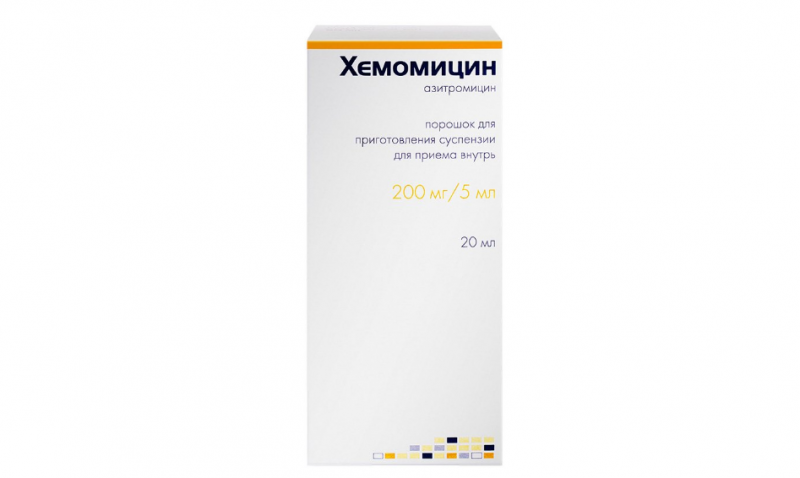Antimicrobials are prescribed by pediatricians only in special cases when the child’s body cannot cope with an infectious disease on its own. In this case, for children, the suspension "Azithromycin" is the most optimal solution. This is one of the most effective and safe medicines.
Material Content:
The composition (active substance) of the drug
Powder for suspension contains the main active ingredient - azithromycin dihydrate. Dosage - 100 and 200 mg in 5 ml of finished product. In addition, the composition includes auxiliary components that enhance the taste characteristics of the antibiotic.
Azithromycin 200 is intended for children weighing over 15 kg, a dose of 100 mg is used to treat babies weighing up to 5 kg.
Pharmacological properties and indications for use
Suspension "Azithromycin Ekomed" for children is an antimicrobial drug of the latest generation. A representative of the macrolides of the azalide subgroup inhibits protein synthesis, preventing bacteria from growing and multiplying. In high concentrations, it acts as a bactericidal agent.
The range of the drug extends to:
- gram-positive cocci (staphylococci, streptococci);
- gram-negative bacteria;
- anaerobes;
- chlamydia
- mycoplasmas;
- ureaplasmas;
- spirochetes and others.
Despite the fact that the drug is effective against most pathogenic microorganisms, there are strains that are resistant to it. Basically, these are all erythromycin resistant bacteria.
The antibiotic is resistant to gastric juice, therefore, it is more effective than drugs of other groups of antimicrobial agents. It is rapidly absorbed into the blood from the intestines, approximately 2 to 3 hours after administration. Its feature is the ability to accumulate in the tissues of organs, from where the drug is gradually excreted within 2 to 4 days. That is why there is no need to take an antibiotic several times a day. The effect of the medication continues after the end of therapy.
The medicine is used for the following diseases:
- infectious diseases of ENT organs - tonsillitis, pharyngitis, laryngitis, sinusitis, otitis media;
- diseases of the lower respiratory tract - acute bronchitis or exacerbation of a chronic form, pneumonia;
- skin infections - pustular lesions, streptoderma, erysipelas;
- genitourinary tract inflammation - urethritis, cystitis, adnexitis, prostatitis;
- pathology of the gastrointestinal tract caused by the Helicobacter pylori bacterium.
The antibiotic "Azithromycin" is one of the safest, therefore it is recommended to use it in the treatment of children from 6 months to 12 years. It is during this age period that its use is most rational, which is associated with the content of the active component in it in the dose necessary for the body.
Note. In order for the treatment to be effective, before taking it, it is necessary to pass the bacteriological culture on the flora and individual sensitivity to antibiotics.
Instructions and dosage of suspension Azithromycin for children
An antimicrobial agent is not sold as a ready-made suspension. To prepare it, you must read the instructions for use, which describes the procedure and indicates the exact dosage.
Preparation differs depending on the dose of the active ingredient. To get 20 ml of a 100 mg suspension, add 10 ml of boiled warm water to the powder bottle. To prepare a 200 mg medicine, you need 15 ml of liquid.
After adding water to the vial, it must be shaken well to dissolve the powder. The finished mixture can be taken after 10 minutes, stored for 5 days in the refrigerator. Storage beyond this period is prohibited.
Eating affects the absorption of the drug, therefore it must be given 1 to 2 hours before or 2 hours after eating. For convenient use, the manufacturer has provided a syringe marked with 2.5 and 5 ml. With it, you can easily enter the drug between the cheek and jaw of the baby.
You can not give medicine when the baby is crying or sleeping, he may choke or choke. If a child spits out or spits up an antibiotic, you must try to give it again after 10 - 15 minutes. If he had vomiting after 30 - 45 minutes, then a second dose is not needed, since the drug is already in the process of absorption into the body.
The course of treatment is 3 days, longer treatment is undesirable.
Important. The antibiotic should be given to the child daily strictly at the same time. If you missed a dose, the dosage does not increase.
"Azithromycin", like any other antibiotic, it is important to take in combination with a probiotic. This is necessary for the normal functioning of the intestines. As the latter, you can use bio-yogurt, "Lactiale baby" or "Linex baby."
Drug interaction
In severe cases, the drug can be combined with other antibiotics, but such therapy is possible only under round-the-clock supervision of medical personnel in a children's hospital.
The medicine is not compatible with heparin, as well as with other blood-thinning medications. Particular attention should be paid to taking an antibiotic in combination with anti-inflammatory non-steroid drugs.
Contraindications, side effects and overdose
This medication should not be given to infants under six months of age, even with the lowest possible dose, it can be detrimental.The outcome can be convulsive syndrome, intestinal and gastric hemorrhages.
The antibiotic is also not suitable for children with kidney and liver diseases. If the baby was previously allergic to azithromycin, then an antimicrobial drug of another group should be preferred.
With hypersensitivity, skin rashes, urticaria appear. Possible headache, nausea, vomiting, bloating. Children can become more restless, naughty, and sleep poorly. Such symptoms are caused by the effect of the drug on the nervous system. Sometimes there are changes in the general analysis of blood in the form of neutrophilia and eosinophilia. Indicators return to normal within 2 to 3 weeks after treatment.
If any side effects are observed, it is necessary to stop using the drug and consult your doctor. In case of an overdose, symptomatic treatment is prescribed.
Antibiotic Analogs
Today, the pharmaceutical market has a huge number of analogues of "Azithromycin" domestic and imported. Most substitutes are made on the basis of the active substance azithromycin dihydrate. When choosing an analogue, individual characteristics of the body should be taken into account.
Substitute List:
- Chemomycin is a complete substitute for Azithromycin. It has identical indications and contraindications, since it contains a similar active substance.
- "Sumamed" is the latest generation antibiotic, more refined. Presented in the form of capsules, tablets and suspensions.
- AzitRus is a macrolide. The suspension may contain 50, 100 and 200 mg of the active ingredient.
With azithromycin intolerance, a substitute based on clarithromycin, Klacid, is suitable. The drug can be taken without regard to food. The finished suspension is stored up to 14 days.


















